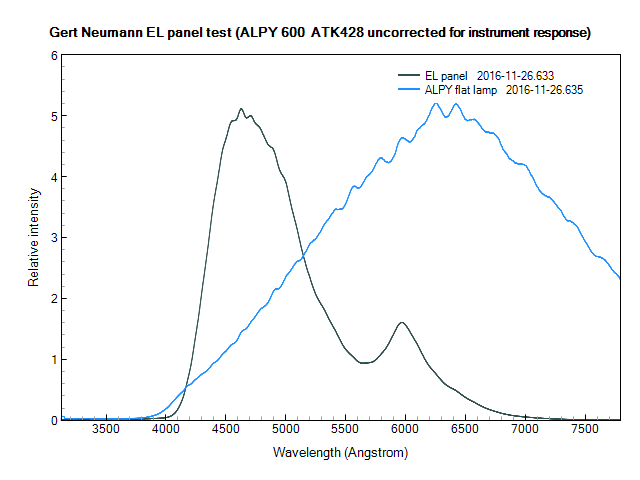› Forums › Spectroscopy › Flats
- This topic has 5 replies, 3 voices, and was last updated 9 years ago by
 Mr Allan Brittan.
Mr Allan Brittan.
-
AuthorPosts
-
25 November 2016 at 4:12 pm #573638
 Mr Allan BrittanParticipant
Mr Allan BrittanParticipanthi,
I’m preparing to start using flats, after being given a broken Gerd Neumann panel for my partner to fix. I read another post about these panels not being great for spectroscopy, but on the Gerd Neumann site found a paper about someones experiments with the panels in comparison to other methods. Although my German isn’t great, what I have translated so far suggests he found it good for spectroscopy. (http://www.astrospectroscopy.eu/Einsteiger/Flats/flats.htm)
kate
25 November 2016 at 4:48 pm #577678Hi Kate,
I made a light box out of ply wood, lined it with white fablon cut a circular hole in the fron and fitted 4 lamps at the front behind the hole. I had a voltage variable control but you could also use a variable resister. Running on a 12 volt reglated transformer(Maplin) it was easy to adjust the flat ADU to about 30,000. Only problem you needed 2 people to a) hold it in front & b) take 16 flats. For the ALPY spectroscope the built in flat lamp is a easier option.
26 November 2016 at 2:21 pm #577682 Robin LeadbeaterParticipant
Robin LeadbeaterParticipantHi Kate,
Yes I know Lothar Schanne who made those tests. I think the Neumann panels work well for high resolution spectroscopy within a limited wavelength range, particularly H alpha with the LHIRES III spectrograph which was what Lothar was doing there. For that particular application they worked better than the usual halogen lamp, matching the defects caused by dust for example. Note that some panels from different manufacturers have some sharp emission lines which make them no good for spectroscopic flats.
I don’t think they work as low resolution wide wavelength range flats (for the ALPY or LISA etc) though as they have a limited wavelength range with no output at the UV and IR ends compared with a halogen lamp. (Francois Cochard commented about this at the recent workshop)
I have a small one knocking about somewhere. I will see if I can dig it out and test it with the ALPY
Cheers
Robin
26 November 2016 at 5:31 pm #577683 Mr Allan BrittanParticipant
Mr Allan BrittanParticipantThank you Nick and Robin. At present I can’t afford the section for the alpy which does flats or the calibration module, so I’m trying to see if what I have will work.i will test the panel and also other methods and see which I can achieve the best results with. it would be interesting to see what results you get Robin.
kate
27 November 2016 at 4:11 pm #577684 Robin LeadbeaterParticipant
Robin LeadbeaterParticipantHi Kate,
I found my Gert Neumann panel and put it in front of the ALPY 600 spectrograph with an ATIK 428 camera. Here is the comparison between the EL panel and the internal ALPY lamp.

(This is effectively the output from the light source x the response of the grating and CCD camera)
As claimed by the supplier, the spectrum of the EL panel is smooth with no obvious lines (The small scale ripples in both spectra are from the camera QE and demonstrates one of the reasons why flat correction is important).
The EL panel could potentially be used as a flat light source for spectroscopy, even though the spectrum shape is very different from the Incandescent Halogen lamp black body curve but unfortunately there is no light from it below 4000A. (The internal Halogen lamp in the ALPY also struggles in this region but in practise it still gives enough output down to ~3600A provided a large number of flat exposures are combined to reduce the noise)
A key difference between imaging and spectroscopic flats is that it is much less important that the field is evenly illuminated since you are only sampling a small slice of the field. Even some variation in illumination along the slit is not important if you are measuring at one position eg as for a star. This means even a crude flat illumination setup can be used. I bought my ALPY before the calibration module came out and used the same flat lamp setup as I used for my LHIRES – A halogen lamp waved a couple of metres in front of the telescope aperture which was covered by a diffuser (actually a pillow case!), similar to Christian Buil’s setup here
http://www.astrosurf.com/buil/isis/guide_alpy/tuto_en.htm
This worked well and I saw no difference when I eventually got the calibration module
Cheers
Robin
EDITED: to mention the grating response
28 November 2016 at 10:25 am #577685 Mr Allan BrittanParticipant
Mr Allan BrittanParticipantHi Robin,
I tested mine over the weekend and got a similar looking curve to yours.

will have to try another method for flats.
kate
-
AuthorPosts
- You must be logged in to reply to this topic.
